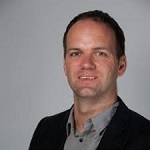Hollow-Core Optical Fibers as Optofluidic Microreactors
Hosted By: Fiber Modeling and Fabrication Technical Group
09 June 2023 10:00 - 11:00
Eastern Time (US & Canada) (UTC -05:00)In this webinar hosted by the Fiber Modeling and Fabrication Technical Group, Tijmen Euser will discuss how optofluidic hollow-core fibers (HCF) can improve our understanding of photocatalytic and electrochemical processes relevant to the green energy transition. Liquid-filled HCFs are excellent sample cells in which light propagates in well-defined modes at the center of a microchannel. The internal sample volumes in HCF can be as small as a few nL per cm interaction length, while long optical paths enable sensitive absorption, fluorescence, and Raman spectroscopy.
Prof. Euser will demonstrate a new operando Raman spectroscopy method that tracks the chemistry of liquid electrolytes during battery cycling. An optofluidic hollow-core fiber is integrated into a working Li-ion cell and used to analyze sub-microlitre electrolyte samples at different stages of the charge-discharge cycle by background-free Raman spectroscopy. Raman measurements over multiple cycles reveal early signs of battery electrolyte degradation. The new methodology contributes to understanding better the limitations of Li-ion batteries and paves the way for studies of degradation mechanisms in different electrochemical energy storage systems.
Subject Matter Level:
What You Will Learn:
• Hollow Core Optical Fibers
• Spectroscopy in Hollow Core fibers
• Microreactors
Who Should Attend:
• UG, PG, and PhD Students
• Professors, Postdoc fellows, and Industry Personnel
About the Presenter: Tijmen Euser from the University of Cambridge
 Tijmen Euser is a University Associate Professor at the Cavendish Laboratory, University of Cambridge. He obtained his PhD in 2007 on ultrafast spectroscopy on photonic crystals with Prof. Willem Vos at the University of Twente and the FOM Institute for Atomic and Molecular Physics in the Netherlands. He then became a postdoctoral fellow with Prof. Philip Russell at the Max Planck Institute for the Science of Light (MPL). The team at MPL developed a range of new applications of hollow-core photonic crystal fibre (HC-PCF), including optofluidic microreactors for photochemistry, sensors based on optically trapped microparticles, and controlled excitation of higher-order fibre-modes. In 2015 he started the interdisciplinary Optofluidics group at the Cavendish Laboratory, where his lab has developed optofluidic techniques to study novel photocatalysts, operando Raman spectroscopy in Li-ion batteries, and optical manipulation of nanoparticles.
Tijmen Euser is a University Associate Professor at the Cavendish Laboratory, University of Cambridge. He obtained his PhD in 2007 on ultrafast spectroscopy on photonic crystals with Prof. Willem Vos at the University of Twente and the FOM Institute for Atomic and Molecular Physics in the Netherlands. He then became a postdoctoral fellow with Prof. Philip Russell at the Max Planck Institute for the Science of Light (MPL). The team at MPL developed a range of new applications of hollow-core photonic crystal fibre (HC-PCF), including optofluidic microreactors for photochemistry, sensors based on optically trapped microparticles, and controlled excitation of higher-order fibre-modes. In 2015 he started the interdisciplinary Optofluidics group at the Cavendish Laboratory, where his lab has developed optofluidic techniques to study novel photocatalysts, operando Raman spectroscopy in Li-ion batteries, and optical manipulation of nanoparticles.
